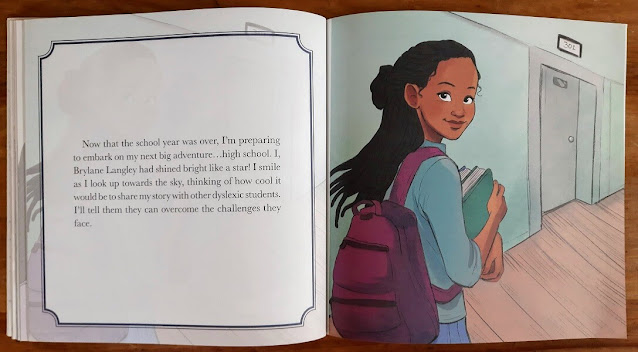Disclosure:
Affiliate links
to Amazon are included in this post.
The Hoopstar was inspired by the true story of a twelve-year-old
girl who's always had a love for basketball. It was where she shined the
most. Brylane knew how to master plays and how to outthink her opponent on
the court, but she struggled with another opponent off the court . . .
Dyslexia. This entertaining story gives readers an enjoyable reading
experience while also teaching them the importance of overcoming
obstacles, building confidence, self-love, courage, and the value of hard
work.
🏀🍎 Title: The Hoopstar
🏀🍎 Author: Chavon D. White
🏀🍎 Illustrator: Bev Johnson
🏀🍎 Publisher: Author House
🏀🍎 Date: April 15, 2019
🏀🍎 Pages: 56
What is dyslexia?
Before reading The Hoopstar with your students, take some time to
talk with them about dyslexia, what it is... and what it isn't... and to
dispel any preconceived notions they may have about it. Here are
some simplified tidbits to talk about with your students:
Dyslexia is not a disease.
It is not contagious or fatal. You can't catch it from someone and people
don't die from it.
Dyslexia is a learning disability.
Some people call it a learning 'difficulty.' Dyslexia affects the area
of the brain that processes language, making it difficult for people who
have it to identify speech sounds and connect them to letters and words.
For a long time people believed that if someone reversed words or letters
while writing, it meant they had dyslexia.
Actually... a lot of people still believe it. This is a bit of a
misconception though. Yes, some people who have dyslexia have
difficulty with reversals... but not everyone with dyslexia does. On
the flip side, there are children without dyslexia who get their words and
letters jumbled up. Reversals are not the best indicator of whether or
not someone has dyslexia.
Having dyslexia does not mean a person is 'dumb' or
'lazy.'
People with dyslexia can lead full and productive lives. Albert Einstein,
Stephen Spielberg, Kobe Bryant, Muhammed Ali, Pablo Picasso, and Leonardo
DaVinci are a few famous people who have... or had... dyslexia. Some of our
American presidents had dyslexia as well: Woodrow Wilson, Andrew Jackson,
and even George Washington. No one calls any of these people dumb or lazy!
To learn more detailed and specific information about dyslexia, please visit
the
International Dyslexia Association's website.
Learning About Character Traits
When Chavon White wrote The Hoopstar, she chose to write it from
the main character's point of view and perspective. Even though
The Hoopstar is realistic fiction inspired by real people and
events, it reads like an autobiography or memoir. We learn about
Brylane's thoughts, feelings, insecurities, goals, and motivations.
We also learn about Brylane's character through her behavior and the
things she says.
Character traits are words and phrases that describe a character’s
personality or qualities that make them who they are. In other words,
how you would describe that character to someone else.
After reading The Hoopstar with your students, take some time to
talk about the main character Brylane. Use the L.I.E. (literal,
inferential, evaluative) questions to probe your students and get them
to say more than 'She's nice' or 'She's a good basketball player.'
Examples of Literal Questions to Ask
- How old is Brylane?
- What grade is Brylane in?
- Who are some of Brylane's friends and teammates?
- What is the name of Brylane's basketball team?
Examples of Inferential Questions to Ask
- Give an example of when Brylane felt _______________. What made her feel that way?
- What character trait was Brylane showing when she _______________?
- What event caused Brylane from feeling _______________ to _______________ in the middle of the story?
Examples of Evaluative Questions to Ask
- Which of Bryalne's character traits do you think Chavon White spotlighted the most throughout The Hoopstar? Why do you think she did that?
- Why do you think Chavon White wanted to write this story about Bylane? What does she want us to learn from Brylane's experiences?
- How could the story have changed if Brylane chose to keep her dyslexia a secret from her friend and the college recruiter?
What are some other skills can you use The Hoopstar to teach?
What are some follow-up activities for The Hoopstar that you can
think of? Share your ideas in the comments below!
To learn more about The Hoopstar, please visit
the author's official website. You can also watch the video trailer for
The Hoopstar below:
Did you enjoy reading this post about The Hoopstar? If so, check
out these blog posts about more children's books featuring Black main
characters:
#representationmatters
- Book + Craft: One Plastic Bag: Isatou Ceesay and the Recycling Women of the Gambia
- Book: The Mermaid and the Grumpy Old Clam by Kirk Kirkpatrick
- Book + Interview: Living in Two Homes Is Tough by Abby Cadet (age 9)
- Book: Draw Me Close to You by Kossim Osseni
- Book: I Move A Lot and That's Okay by Shermaine Perry-Knights
- Book: That's Not Fair! Why Must I Cut My Hair? by Paul M. Bowen
- Book: There is a Girl Headed to the White House by Dr. Jasmine Killiebrew, Ph.D.
- Book + Printable: Matching Costumes by DG Driver







